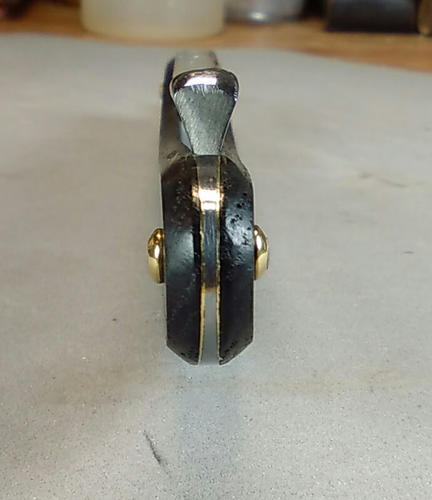Results 1 to 9 of 9
 32Likes
32Likes
Thread: re: scale shaping - how to make consistent beveled edges ?
Hybrid View
-
04-01-2019, 04:34 PM #1Senior Member

- Join Date
- Feb 2016
- Location
- pennsylvania
- Posts
- 302
Thanked: 66 re: scale shaping - how to make consistent beveled edges ?
re: scale shaping - how to make consistent beveled edges ?
i feel like im able to make rounded scales that i am desiring in many shapes and sizes, but the flat-sided with a 'beveled' edge still eludes me. i can get a (fairly) consistent beveled edge all the way around the scale initially using a vertical belt sander, but when i move up the sanding progression, or especially when i put the scales on the buffer for a final smooth-n-polish, i lose the hard edge and soften the line between bevel and (flat) side. i hope i am making sense and explaining properly.
i was thinking about maybe using a drum sander but i would also need something else to rest the scale against to ensure the same uniform bevel angle. i was also considering a router as the router bit itself could impart the desired angle. but again, once i take the scale to the buffer ill most likely lose that nice hard edge between the two.
so my question is this ... how are you other scale makers out there able to put a scratch-free polish on your scales without ruining that nice clean separation between the flat side and the beveled edge?
any advice would be greatly appreciated.
thanks!
-
The Following User Says Thank You to sloanwinters For This Useful Post:
ScoutHikerDad (04-01-2019)
-
04-01-2019, 04:45 PM #2

Hand finishing
What a curse be a dull razor; what a prideful comfort a sharp one
-
The Following User Says Thank You to Steel For This Useful Post:
sloanwinters (04-01-2019)
-
04-01-2019, 05:36 PM #3

I rough out bevels and radii with a piece of scratch stock then sand by hand. If you have any pieces of bandsaw blades laying around, handsaws you don’t care about or cabinet scrapers, you can use fine files to create your desired profile then get to scraping, just be mindful of grain direction whether it’s wood or horn.
-
The Following User Says Thank You to jfk742 For This Useful Post:
sloanwinters (04-01-2019)
-
04-01-2019, 05:39 PM #4

I prefer to take that line away and make a smooth rounded edge. The flat is still there but the edge is rounded completely up to it.
It's just Sharpening, right?
Jerry...
-
The Following User Says Thank You to Gasman For This Useful Post:
sloanwinters (04-01-2019)
-
04-01-2019, 06:40 PM #5

For period correct scales say 1800 - 1830 I like that clear distinct bevel along the edge of the scales. I see many examples from that time frame that are flat with the bevel. Here is a link to a recent post with that type of scale in bone but is most common in horn.https://sharprazorpalace.com/custom-...40-j-shaw.html The material in a rough profile from the band saw is taped together using double sided tape. Some use rubber cement but there is no dry time with the tape and it holds well for me. I do not recommend carpet tape. It's much stronger than needed and you may damage a thin set of scales separating them. The scales are finish profiled on a belt grinder. I use a 1 x 42 with 80 grit. Here's a post from a few years ago on how I make my scales. https://sharprazorpalace.com/worksho...-way-i-do.html The process is pretty much the same for flat scales with a beveled edge. Reduce the scales to final thickness and then hold against the belt at an angle and rough in the bevel. Make long continuous passes so the cut is not wavy. Having an original set of scales to copy helps. Next back to my bench and I use a scraper to true up the bevel. Then a hand file and finally various grit of wet/dry paper. I sand dry but choose the wet/dry because it has better glue and lasts longer than regular sandpaper. Use a firm backing when sanding the scales flat and for the bevel. A small block of wood or hard felt will work. Sanding with too soft a backing or worse no backing will destroy the clean lines you have created and even create waves in the surface. A desk type lamp that you can swivel the head on to create shadows on your work will help greatly to see your progress.
Hope this helps.Last edited by karlej; 04-01-2019 at 10:13 PM.
-
The Following 5 Users Say Thank You to karlej For This Useful Post:
evnpar (04-02-2019), outback (04-01-2019), RezDog (04-02-2019), sloanwinters (04-01-2019), Steel (04-01-2019)
-
04-01-2019, 08:00 PM #6

Thats pretty much how I do them. Minus the belt sander.
A piece if sandpaper wrapped around a paint stick, works wonders.
I f its horn u may want to refrain from using the buffer on the very edge, do that part by hand. U won't notice any difference if sanded to a high grit.

Always buff off an edge, never into it. BTWMike
-
The Following 3 Users Say Thank You to outback For This Useful Post:
RezDog (04-02-2019), sloanwinters (04-01-2019), Steel (04-02-2019)



 LinkBack URL
LinkBack URL About LinkBacks
About LinkBacks







 Reply With Quote
Reply With Quote


